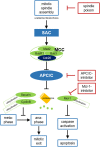The Role of the APC/C and Its Coactivators Cdh1 and Cdc20 in Cancer Development and Therapy
- PMID: 35832196
- PMCID: PMC9273091
- DOI: 10.3389/fgene.2022.941565
The Role of the APC/C and Its Coactivators Cdh1 and Cdc20 in Cancer Development and Therapy
Abstract
To sustain genomic stability by correct DNA replication and mitosis, cell cycle progression is tightly controlled by the cyclic activity of cyclin-dependent kinases, their binding to cyclins in the respective phase and the regulation of cyclin levels by ubiquitin-dependent proteolysis. The spindle assembly checkpoint plays an important role at the metaphase-anaphase transition to ensure a correct separation of sister chromatids before cytokinesis and to initiate mitotic exit, as an incorrect chromosome distribution may lead to genetically unstable cells and tumorigenesis. The ubiquitin ligase anaphase-promoting complex or cyclosome (APC/C) is essential for these processes by mediating the proteasomal destruction of cyclins and other important cell cycle regulators. To this end, it interacts with the two regulatory subunits Cdh1 and Cdc20. Both play a role in tumorigenesis with Cdh1 being a tumor suppressor and Cdc20 an oncogene. In this review, we summarize the current knowledge about the APC/C-regulators Cdh1 and Cdc20 in tumorigenesis and potential targeted therapeutic approaches.
Keywords: APC/C; Cdh1; antimitotic therapy; mitotic exit; mitotic slippage; spindle assembly checkpoint.
Copyright © 2022 Greil, Engelhardt and Wäsch.
Conflict of interest statement
The authors declare that the research was conducted in the absence of any commercial or financial relationships that could be construed as a potential conflict of interest.
Figures


References
-
- Ayuda-Duran P., Devesa F., Gomes F., Sequeira-Mendes J., Avila-Zarza C., Gomez M., et al. (2014). The CDK Regulators Cdh1 and Sic1 Promote Efficient Usage of DNA Replication Origins to Prevent Chromosomal Instability at a Chromosome Arm. Nucleic Acids Res. 42, 7057–7068. 10.1093/nar/gku313 - DOI - PMC - PubMed
Publication types
LinkOut - more resources
Full Text Sources
Miscellaneous

